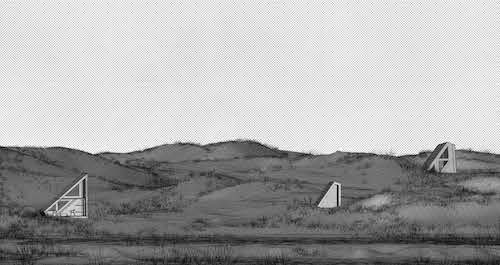A Harvard Graduate School of Design student team is one of five winners in a unique competition titled “A Beautiful Decay,” an endeavor of Miami-based initiative Save Before Quitting. GSD students B. Cannon Ivers, Devin Dobrowolski, and Mary Catherine Miller (all MLA ’16) entered the competition in June and were announced as winners on September 8.
The competition was themed around the viability of current habitation methods amid changing landscapes and conditions, with an eye toward climate change. Ivers, Dobrowolski, and Miller submitted a project titled Wanderers, which they completed in the Fall 2014 studio course Infrastructural Ecologies taught by associate professor of landscape architecture Pierre Bélanger. Lecturer in architecture and landscape architecture Luis Callejas served as lead critic on the project.
Alongside the other four winning projects, Wanderers went on exhibit at the Opa-Locka Arts & Recreation Center in Miami this past Saturday, September 19, and will be on display until October 13.
Employing the Cape Cod National Seashore as a lens, Wanderers explores topics of site specificity and local vernacular and how these concepts might evolve within the context of climate change. Nodding to shifting aspects of the landscape—morphing sand dunes, rising and falling tides, and growing vegetation—Wanderers presents unfixed structures that would transition with the dune and marsh landscapes. The structures would also be temporarily occupied by visitors, whether for weeks or for minutes.
The team hopes that their work brings the role of landscape into focus and highlights the importance of both decoding the local vernacular that makes a place unique and offering novel forms of human activity in landscapes that are most susceptible to morphological change.
“We as landscape architects are interested in ‘formation rather than form,’ to quote [assistant professor of landscape architecture] Rosetta Elkin,” Ivers says. “We hope Wanderers will provoke a reassessment of the role of landscape architecture in the wider discipline of design to shape the future—ecologically driven, restorative, projective, urban, and infrastructural.”
Throughout the design development of Wanderers, the team explored different forms of media, ranging from analog and digital animations to fabrication with wood, foam, and three-dimensional printing. The finished project employs a 4’x4’ lightbox and a 4’x4’ marsh model filled with water, as well as models in a range of scales and materials, but all tactile and moveable.
As issues around climate change and shifting landscapes maintain global interest, the team hopes that their project and the “A Beautiful Decay” exhibition can offer insight into how not only landscape but also human culture can build resilience in the face of risk and disaster.
“It is hard for people to imagine these kinds of landscapes being altered or even disappearing completely,” Dobrowolski says. “Wanderers attempts to be projective about how that transition might happen. The images we produced try to get at this in a visceral way.”
Photo: A rendering of some of the temporary structures presented in Wanderers
